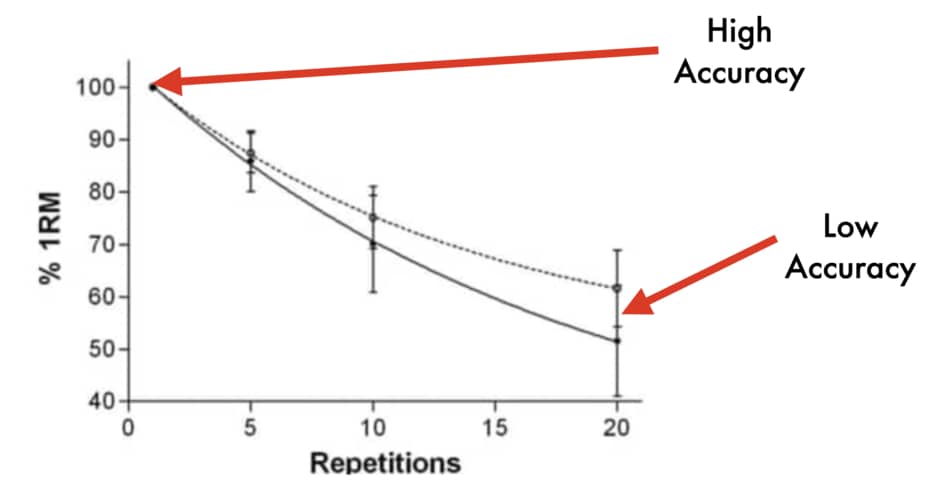For most beginners, getting to bench 135 can be tough because it requires hard work and patience. However, once you get to that level of strength the next big thing is to put two plates on the bar.
Today I will explain how many repetitions of 135 bench it takes to push 225, and most importantly, how long it will take based on your current strength.
On average, it takes around 20 reps of 135 to be able to bench 225, based on the American College of Sports Medicine Guidelines for the 1RM test. However, the individual number of repetitions will depend on the anthropometric variables such as body mass, total arm length, biacromial width, and training experience.

I will also touch on the accuracy of the one-repetition maximum equations, especially when it comes to the higher rep range.
How To Know If You Can Bench 225?
Overall, to know if you can bench 225 you can either perform a 1RM test, or you can use the one-repetition maximum equations.
One maximum repetition (1RM) test is one of the most effective ways to assess physical strength on the bench.
1RM test involves benching the heaviest load that can be moved through a full range of motion, and with correct form.
However, using 1RM as a testing protocol is problematic (and generally not necessary) because it requires preparation:
- Firstly, you need to warm up by benching several submaximal reps.
- Secondly, you should have at least a 3 to 5 minutes break between the sets (including preparation sets).
- Thirdly, all reps should be done with correct form, at the same speed of movement and complete range of motion.
- Fourthly, you need a person like a spotter who can help you in case something goes wrong.
- Fifthly, you should be in good overall health.
For these reasons, lifting maximum weight is not recommended for:
- Teenagers
- Rehabilitation patients
- Elderly people
The good news is you can still assess your strength using the 1RM-predicting equations that estimate your 1RM based on how many reps you did with a lower weight.
For example, you can do 135 bench press for a number of reps to establish what is your 1RM, 5RM, or 10RM.
Related: Click here to learn more about how many reps of 225 to bench 315.
How Many Reps Of 135 To Bench 225?
According to ACSM’s Guidelines for Exercise Testing and Prescription protocols, you need to do around 20 reps of 135 to bench 225. On the other hand, if you can do 25 reps of 135 you should be able to bench 250lbs as your one-rep maximum.
Keep in mind that this is not always the case.
For example, some people can have higher absolute strength (which means they are strong in the 1-5RM range) but have poor muscle endurance. Muscle endurance and muscle strength are not the same.
If you use a training program designed to increase muscular strength and power, this will impact your absolute strength. However, if you’re training with a lower weight for high reps, this will improve your muscle endurance.
In other words, some people can be able to easily bench 225 as their 1RM, however, they may struggle to bench 135 for 20-25 reps.
20 Reps of 135 To Bench 225
In general, it takes 20 reps of 135 to bench 225 for one rep. However, you need to keep in mind that the accuracy of the 1RM-predicting equations can vary depending on the number of reps you do.
Let me explain.
Predicting the 1-RM equation is accurate for bench press, as long as you stay with no more than 10 repetitions range. Multiple studies have shown that the 5-RM range produced the greatest prediction accuracy.
Take a look at the graph below.

In the graph above you can see the results of the study done by the University of New Mexico where they assessed the accuracy of prediction equations for 1 repetition maximum from the multiple rep range.
This means that the most accurate prediction of strength happens at 5-RM, and the accuracy of prediction gets worse (around 90% accuracy) with increasing repetitions to failure.
In other words, doing 20 reps of 135 may not always guarantee that you can bench 225 as your 1-RM. However, doing 21 or 22 reps of 135 can almost guarantee you can be able to hit 225.
How Many Times Should I Rep 135 To Bench 225
Below you can see the table with one rep max calculations based on how many reps of 135 you can bench. The variety of rep max ranges from 1RM to 25RM.
For example, if you can bench 135 for 10 reps, this means you should be able to bench 180 lbs as your one-rep max.
On the other hand, if you can bench 135 for 6 reps, that means your one-repetition maximum should be around 156 pounds.
See below.
| How Many Reps Of 135 Bench? | What is your 1RM? |
|---|---|
| 1RM | 135 lbs |
| 2RM | 138 lbs |
| 3RM | 143 lbs |
| 4RM | 147 lbs |
| 5RM | 151 lbs |
| 6RM | 156 lbs |
| 7RM | 162 lbs |
| 8RM | 167 lbs |
| 9RM | 173 lbs |
| 10RM | 180 lbs |
| 11RM | 184 lbs |
| 12RM | 189 lbs |
| 13RM | 193 lbs |
| 14RM | 198 lbs |
| 15RM | 202 lbs |
| 16RM | 207 lbs |
| 17RM | 211 lbs |
| 18RM | 216 lbs |
| 19RM | 220 lbs |
| 20RM | 225 lbs |
| 21RM | 229 lbs |
| 22RM | 234 lbs |
| 23RM | 238 lbs |
| 24RM | 243 lbs |
| 25RM | 248 lbs |
As you can see in the table above, there is a progression that adds 4-5 lbs to your estimated 1RM.
This means that with every extra rep you do on the bench press with a 135 lbs barbell, your one-rep max will go up by 4-5 pounds.
How many reps of 135 to bench 225?
On average, you need to do anywhere from 20 to 21 reps of the bench press exercise with a weight of 135 lbs to lift 225 as your one-rep max.
These numbers are based on the scientifically-based standards of exercise testing, however, they do not take into consideration your training experience, weekly training volume, and body anthropometry.
How Long Does It Take To Go From Benching 135 to 225?
Overall, it can take 6-12 months of regular training and a well-balanced nutrition plan to be able to move from benching 135 to 225 for reps.
The best way to improve your bench is to focus on strength training that includes multi-joint compound exercises and progressive overload to stimulate hypertrophy.
On the other hand, people who are busy with work, relationships, and family commitments may not have optimal time and energy to spend on strength training.
In that case, the journey from 135 to bench 225 may take longer.
Getting stronger is not just to be able to lift more weight, but also to balance your stress, sleep, and nutrition.
The highest strength growth is the direct reflection of everything else you do outside of the gym
For example, if you’re hitting the gym 3-4 times per week, your nutrition is sound, and you have figured out your work-life balance that is stress-free, going from 135 bench to 225 will take no time.
On the other hand, if you’re juggling between two jobs, working late and waking up early, raising a family, and like to drink on the weekends, lifting 225 from 135 may take forever.
I’m not gonna go into the details of how many people can actually bench 225. I’ve already covered that in my article on how many people can bench 225, which I recommend you read.
How To Go From 135 To Bench 225 Faster?
The fastest way to get from 135 bench to 225 is by doing strength training with a low repetition range from 1 to 5 repetitions per set using heavy loads (around 70-90% of 1-repetition maximum).
To further optimize muscle protein synthesis, you also need to eat protein-rich foods and have enough sleep to reduce cortisol and increase testosterone.
In other words, increasing the bench from 135 to 225 takes a lot of pieces of the puzzle. It’s not just hitting the gym once a week and hoping for the best.
Here you can see a case study from Kristian on how he went from benching 135 to an impressive 225 for reps.
135 To 225 Bench Press Training Program
Here are 9 strategies that will help you to get from 135 to 225 bench faster:
- Train one day ON and one day OFF – This will help to reduce muscle soreness, and maximize recovery to grow muscle.
- Focus on compound movements – Lifting big weights increases testosterone levels, which acts as an anabolic stimulus on all of the muscle groups.
- Have a spotter – To lift heavy weights ensure you always exercise with a training partner that can help you pass the muscle failure to further stimulate growth.
- Use periodization plan – To go from 135 to bench 225 follow a workout program that includes strength, hypertrophy, and muscle endurance to hit all of the muscle fibers and maximize gains. A moderate repetition (8 to 12 repetitions per set) with 60% to 80% of 1-RM optimizes muscle size.
- Take long rest between the sets – When using big compound movements like bench, squats, deadlifts, and rows, spend extra time for rest (anywhere between 3-5 minutes is enough).
- Stay in a calorie surplus – Eating more calories will allow you to push more weight on every workout, whereas dieting can limit your muscle growth potential.
- Eat more proteins – going faster from 135 bench to 225 requires a lot of strength and muscle growth, therefore, you need to ensure you have protein-rich food with every meal you eat.
- Drink a lot of water – Studies have shown that dehydration can result in approximately 1.5% loss of body mass adversely affecting bench press 1RM performance (Schoffstall et al. 2001).
- Take carbs and amino acids during a workout – Getting carbs and amino acids can significantly enhance your performance. Carbs during a workout are an excellent way to replenish the loss of glycogen, whereas amino acids prevent excessive muscle protein breakdown.
Bench Transformation From 135 To 225
In general, to go from 135 to 225 bench takes time and practice. Some people manage to do it in 12 months, whereas others need more time.
Here you can see the case study from Max Strazny where he documented his Bench Transformation from 135 to 225 in less than a year.
As you can see, Mark used compound exercises with progressive overload over a period of time to transform his physique. The end results are impressive.
Conclusion
As you can see, it may take 20 to 21 reps of 135 to bench 225 for one rep max. However, please remember that muscle endurance and muscle strength are not the same, which means getting 20 reps of 135 may not always guarantee to hit 2 plates on the barbell.
Don’t be discouraged. I still remember my first rep of 225 and it was magical. If you want to improve your bench press further, I recommend you use heavier weights and stick to the multi-joint movement.
